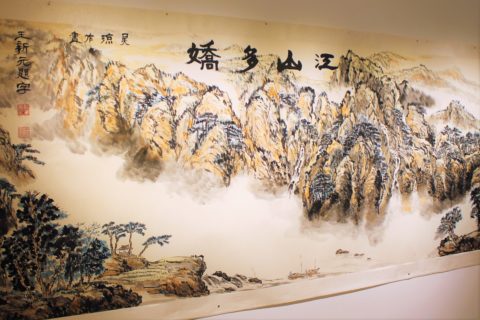The Confucius Institute and the Gordon Snelgrove Gallery at the University of Saskatchewan have installed an exhibit from July 17 to 28, which showcases modern interpretations of traditional Chinese artwork from collection of calligrapher Wang Xinyuan.
The Sheaf met with Xinyuan at the Gordon Snelgrove Gallery to talk about the exhibit and how he hopes it can foster a better relationship between Chinese and Canadian peoples.
The exhibit features more than 50 pieces from famous Chinese artists and calligraphers, including Xinyuan himself. Notable artists featured in the exhibit include Huang Qi, Liu Wenxi, Mi Nanyang, Wu Yuru, Li Henian and Liu Bingsen.
In recognition of Canada 150, Xinyuan’s collection was brought over from China and installed at the Snelgrove gallery to facilitate relations of mutual respect and appreciation between Chinese and Canadian peoples. Xinyuan’s intention is to strengthen this relationship through art. Whether it is the sheer beauty of the different forms of Chinese artwork or the messages and meanings contained within these works, this exhibit exposes viewers to some of the intricacies of Chinese culture.
A large portion of the exhibit features works of Chinese calligraphy, either as standalone pieces or integrated into larger paintings. Stylistically, each work varies in brush size, character size, character type, pressure and stroke technique.
While the aesthetics of the calligraphy are eloquent to the eyes of both Chinese and non-Chinese viewers, the messages embedded within these works are also of great importance and meaning. The meanings in the calligraphy pieces range from poetry to personal memoirs. Many of the pieces in the exhibit were gifted to Xinyuan and have inscriptions personally addressed to him.
Using intricate brushwork techniques paired with the traditional mediums of black ink and colored pigments on rice paper, the exhibit also showcases a broad range of scenic and nature-based material. This exhibit captures the day-to-day beauty found in our natural surroundings while also incorporating culturally significant depictions of figures and symbols.

From blooming branches of cherry blossoms to dragons weaving along the horizon, the collection portrays conventional and naturalistic settings that transcend into the realms of Buddhism, folklore and mythology.
The scenes depicted are striking, in a delicate yet bold manner. The black linework of the paintings adds definition and precision to the work, while the layered watercolours serve to soften these features. Taken together, these artistic elements capture each subject’s inner essence, and the viewer can detect the artist’s energy and precision flowing through every brushstroke.
In addition to landscapes and natural settings, the exhibit has an anthropological element, providing viewers with a glimpse into the cultural facets of Chinese society. The exhibit depicts men and women clad in many garments and placed in various settings with forms of Chinese architecture, such as quaint village homes and buildings decorated with inclined and sweeping roofs.
The human-based components of the exhibit capture the dynamism and potency of everyday life by focusing on intimate settings. In these depictions, the backgrounds are often left blank, directing the viewer’s attention to the subject alone. This gives the viewer a more refined understanding of and connection to the emotional and spiritual content of the work.
The complex meanings and interpretations that the viewer draws from these art pieces also have the effect of simultaneously fostering cultural appreciation, learning and understanding. The exhibit does so in two-fold by showcasing traditional art styles and techniques while also giving viewers a look into many different components of Chinese culture.
Xinyuan has also donated some of his own work and the works of other Chinese artists to the U of S Department of Art and Art History archives, as a gesture of good fortune to the university.
—–
Jessica Quan